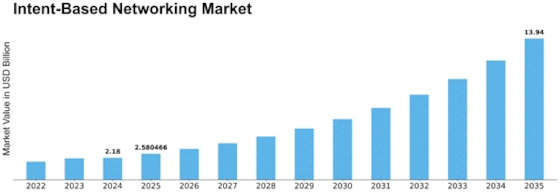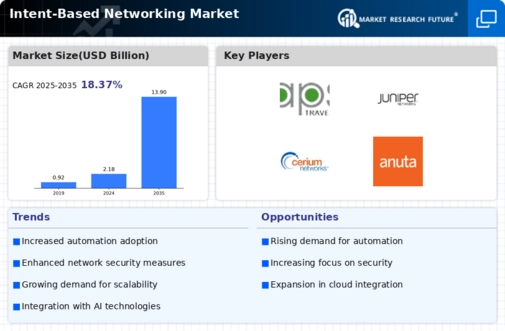Intent Based Networking Size
Intent Based Networking Market Growth Projections and Opportunities
Intent-Based Networking (IBN) has transformed corporate network management and optimization. Many market drivers are driving intent-based networking's growth, a major participant in digital infrastructure's ever-changing environment. One reason for the need for intent-based networking solutions is the increasing complexity of today's networks. Traditional network management approaches are struggling to keep up with the complex structure of current information technology systems as firms increase their digital footprints. IBN automates network setup, management, and troubleshooting based on goals to solve this problem. This simplifies processes and minimizes IT workload. AI and ML are becoming increasingly crucial in network management, another industry-changing factor. These technologies allow Intent-Based Networking to understand and assess network data and make real-time decisions and changes based on correct information. This intelligence-driven strategy increases network security, performance, and reliability and follows the trend of organizations prioritizing advanced analytics for proactive network management. Agility and flexibility are key to intent-based networking's growth. IBN allows firms to quickly adapt to changing demands in today's fast-paced business environment. Automatically converting business regulations into network settings allows for more flexibility in meeting changing needs, which boosts innovation and competitiveness. Expanding cloud computing is another market driver for intent-based networking. More companies are moving their workloads and applications to the cloud, making a dynamic and responsive network essential. IBN seamlessly integrates on-premises and cloud networks. This link simplifies network management and ensures a uniform user experience across infrastructure. The technology's cost-effectiveness is also driving intent-based networking adoption. By automating network administration tasks, organizations may optimize resource utilization, save operating costs, and eliminate human error. IBN efficiency gains save money and free up IT staff to focus on critical initiatives, increasing corporate productivity. Security considerations are a major market factor in intent-based networking adoption. IBN automation and intelligence provide real-time threat detection and response, improving network security. Many firms use IBN to boost their network defenses and maintain a resilient infrastructure. Due to rising cybersecurity dangers.

















Leave a Comment